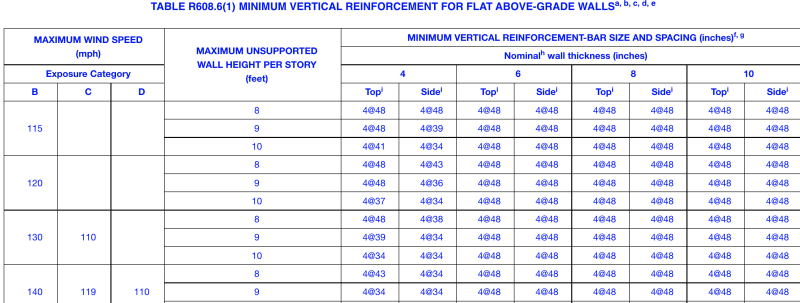Adubdavis:
I was involved with a few of those ICF’s years ago, and haven’t touched one since, and my memory is failing me too. But….,
1. I’ve seen the big voids mentioned above. You can’t have/tolerate them, and they say they never happen because you usually can’t see or detect them without some extra effort. I believe we used self-consolidating concrete and a very small pencil vibrator. You can kinda thump the outside of the forms too, but it isn’t just pump the conc. in from above either. In any case the aggregate must be small. They look kinda like a large/thick waffle if you stirp the forming off. There are continuous voids/cells both horiz. and vert. at regular intervals, so you should have some options for rebar other than 48” o/c. That may work sometimes, and they sell that, it makes their system look inexpensive and easy to do, but they aren’t signing the drawings or dealing with the client when things start to go south. My rebar would fall someplace btwn. IRC and IBC, depending upon the actual conditions. We know that a conc. wall is plenty adequate for a two story house w.r.t. the gravity loads, so it is the lateral loads, soil, wind, etc. which really dictate the rebar and it’s basically in the center of the wall thickness, not out near the face.
2. You have to do a real good job of fitting the ICF blocks together. They have to be carefully plumbed and well braced laterally during the conc. pouring operation, maybe even tied through at some cutouts and the like, with extra bracing too. As I recall, we put a 24 key in the top of the footing, and really cleaned that out before setting the ICF form blocks, so we would get good keying.
3. As I recall, at window openings and the like we put in head and jamb bucks, tied into the forms, with the jambs blocked up by short 2x’s, and we left the sill bucks off, so we could see what was going on down there. We poured from both sides until the cell voids space below the opening started filling up and then moved on for awhile. Then we’d come back and fill and finish the rest of that area from the open sill buck at the bot. of the window opening.
4. This all seemed kinda fiddly to the builder, after the bill of goods he’d been sold by the ICF people, and they bitched a lot. But, we had some good pictures of some major blow-outs, large wall area failures, large voids within the wall cells, out-of-alignment walls, etc., and that made believers out of them. Didn’t stop the bitching tough. Isn’t this always the case, the new guy sells his product as the best thing since sliced bread, and twice as cheap and easy, but forgets to mention all the special precautions needed, and then is long gone when the problems start happening.

